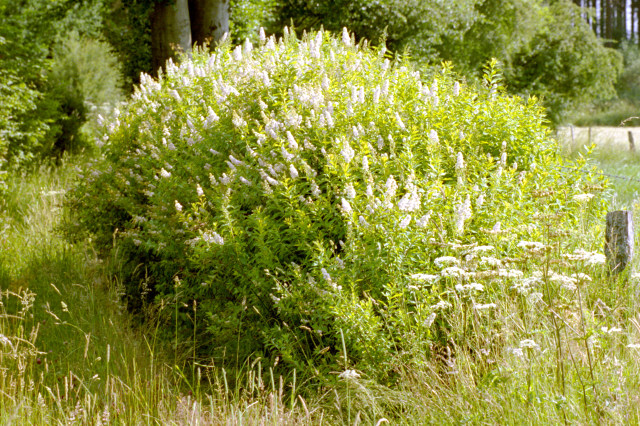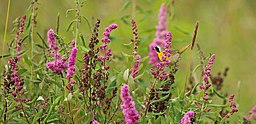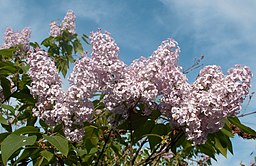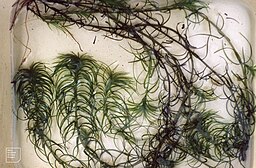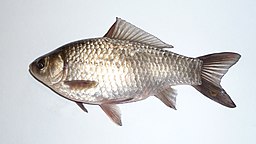 |
Canadian poplar | Status LU: established. 1st record: LU 1823, ITW 1987. |
 |
Kanadesch Pëppel | Status Eur.: established. |
 |
Peuplier noir hybride | RA: ISEIA: C3. Harmonia+: 0,24. |
 |
Bastard-Schwarz-Pappel | Wikipedia: |
 |
Canadapopulier | Back to the list of neophytes |
Contents
Brief description
 Populus ×canadensis Moench is a tree species that originates from hybridisation events between P. nigra, the European poplar and two American poplars, P. deltoides and P. angulata. It occurs in many varieties and can appear spontaneously wherever the parent species is present, but is also commonly bred and planted all over the world. The Canadian poplar thrives on periodically inundated flood plains, nonetheless it can also be found in ruderal areas. The tree threatens to extinguish its parent species and can contribute to the desiccation of its wetland habitats.
Populus ×canadensis Moench is a tree species that originates from hybridisation events between P. nigra, the European poplar and two American poplars, P. deltoides and P. angulata. It occurs in many varieties and can appear spontaneously wherever the parent species is present, but is also commonly bred and planted all over the world. The Canadian poplar thrives on periodically inundated flood plains, nonetheless it can also be found in ruderal areas. The tree threatens to extinguish its parent species and can contribute to the desiccation of its wetland habitats.
Status and distribution in Luxembourg
Records of Populus ×canadensis Moench in Luxembourg. Data source: Recorder-Lux, iNaturalist & GBIF, 2025-08-02.
Populus ×canadensis Moench was first mentioned in Luxembourg under its synonym Populus monilifera Willd. (Tinant 1836: 490). Koltz (1873: 153) and Krombach (1875: 415) state that Populus canadensis [sic] is “common and grown in avenues where only male feet are most often found”.
But Koltz (1875: 138) specifies its 1st record in today Luxembourg in 1823: “Originally from North America as far away as Illinois and Virginia, Populus canadensis Moench was introduced in 1812 in Preisch Park, and in 1842 as P. lævigata and P. molinifera in Walferdange Park. Cultivated as avenue tree. The one which was planted in the Schrassig Park in 1823, has now a trunk girth of 3,66m at shoulder height”.
The oldest herbarium specimen at the MNHNL was collected on 21 April 1935 by Jos. Witry in Bergem (Specimen № 50719, MNHNL 2000-). The next scientific record that we know of was made by Léopold Reichling (1921-2009) on 2nd September 1983 in Ehnen (Municipality of Wormeldange).
The first record in the wild seems to have been documented on 1987-09-03 by Max Lauff and Mariette Scheuer along the Millebaach in Beckerich (MNHNL 2000-).
Currently, 86 records of the Canadian poplar are accessible through the MNHNL-mdata portal (MNHNL, iNaturalist & GBIF 2019).
The Canadian poplar is rather common in Luxembourg.
Other poplar hybrids and varieties
Many poplar hybrids from artificial crosses between P. nigra and North American P. deltoides, complicated by return crosses, selections and various improvements, are grouped under the name of Populus ×canadensis; some cultivars are old (about two centuries), others of more or less recent origin. Often, some only include male individuals, while others are female gen. The main varieties and forms traditionally cultivated are var. canadensis, var. gelrica (Houtzagers) Geerinck and var. marilandica (Bosc ex Poiret) Rehd. Some subspontaneous poplars (riversides…), which may result from spontaneous return crosses between Populus ×canadensis and P. nigra, are of delicate determination (Lambinon & Verloove 2012: 230-231).
Risk assessment
ISEIA protocol
C3 (2+2+2+1) (Ries et al. 2013: 18).
Harmonia+ protocol
Overall risk score 0,24 = (Overall Invasion score 0,66 x Overall Impact score 0,37) (Ries et al. 2020).
 Invasion
Invasion0,37

 Impact
Impact0,24

 Risk
RiskWorldwide distribution
Bibliography
- GBIF 2020. Populus canadensis Moench in GBIF Secretariat (2019). GBIF Backbone Taxonomy. Checklist dataset https://doi.org/10.15468/39omei [accessed 2020-03-02]
- Koltz, J.-P.-J., 1873. Prodrome de la flore du grand-duché de Luxembourg. Première partie. Plantes phanérogames. Imprimerie V. Buck, Luxembourg. 279 S.
- Koltz, J.-P.-J., 1875. Dendrologie luxembourgeoise. Catalogue des arbres, arbrisseaux et arbustes spontanés, subspontanés ou introduits dans la culture du Grand-Duché de Luxembourg. Imprimerie V. Buck, Luxembourg. 217 p.
- Krombach, J.-H.-G., 1875. Flore du grand-duché de Luxembourg. Plantes phanérogames. 564 p. Luxembourg, Imprimerie Joris.
- Lambinon J. & F. Verloove, 2012. Nouvelle flore de la Belgique, du grand-duché de Luxembourg, du Nord de la France et des régions voisines. Sixième édition. Avec la collaboration de L. Delvosalle, B. Toussaint, D. Geerinck, I. Hoste, F. Van Rossum, B. Cornier, R. Schumacker, A. Vanderpoorten et H. Vannerom. Jardin botanique national de Belgique, Meise. CXXXIX + 1195 pp. ISBN : 9789072619884.
- MNHNL, 2000-. Populus ×canadensis Moench in Recorder-Lux, database on the natural heritage of the Grand Duchy of Luxembourg. Musée national d’histoire naturelle, Luxembourg. URL: https://mdata.mnhn.lu [Accessed 2019-10-14]
- MNHNL, iNaturalist & GBIF, 2019. Populus ×canadensis Moench in MNHNL-mdata, online portal combining species observation from Recorder-Lux, iNaturalist and GBIF. National Museum of Natural History, Luxembourg. URL: https://mdata.mnhn.lu [Accessed 2019-10-14]
- Ries, C. & Y. Krippel, 2021. First records of 56 invasive alien vascular plants in Luxembourg. Bulletin de la Société des naturalistes luxembourgeois 123: 115-127. [PDF 241 KB]
- Ries, C., Y. Krippel & M. Pfeiffenschneider, 2020. Risk assessment after the Harmonia+ protocol of invasive alien vascular plant species in Luxembourg. Bull. Soc. Nat. luxemb. 122: 197-205. [PDF 132 KB]
- Ries, C., Y. Krippel, M. Pfeiffenschneider & S. Schneider, 2013. Environmental impact assessment and black, watch and alert list classification after the ISEIA Protocol of non-native vascular plant species in Luxembourg. Bull. Soc. Nat. luxemb. 114: 15-21. [PDF 652 KB]
- Tinant, F. A., 1836. Flore luxembourgeoise, ou, Description des plantes phanérogames, recueillies et observées dans le grand-duché de Luxembourg, classées d’après le système sexuel de Linnée. 512 p. Luxembourg, J. P. Kuborn.
Page content last updated on 2021-03-05. Last proofread by Caroline Grounds on 2019-11-20.






